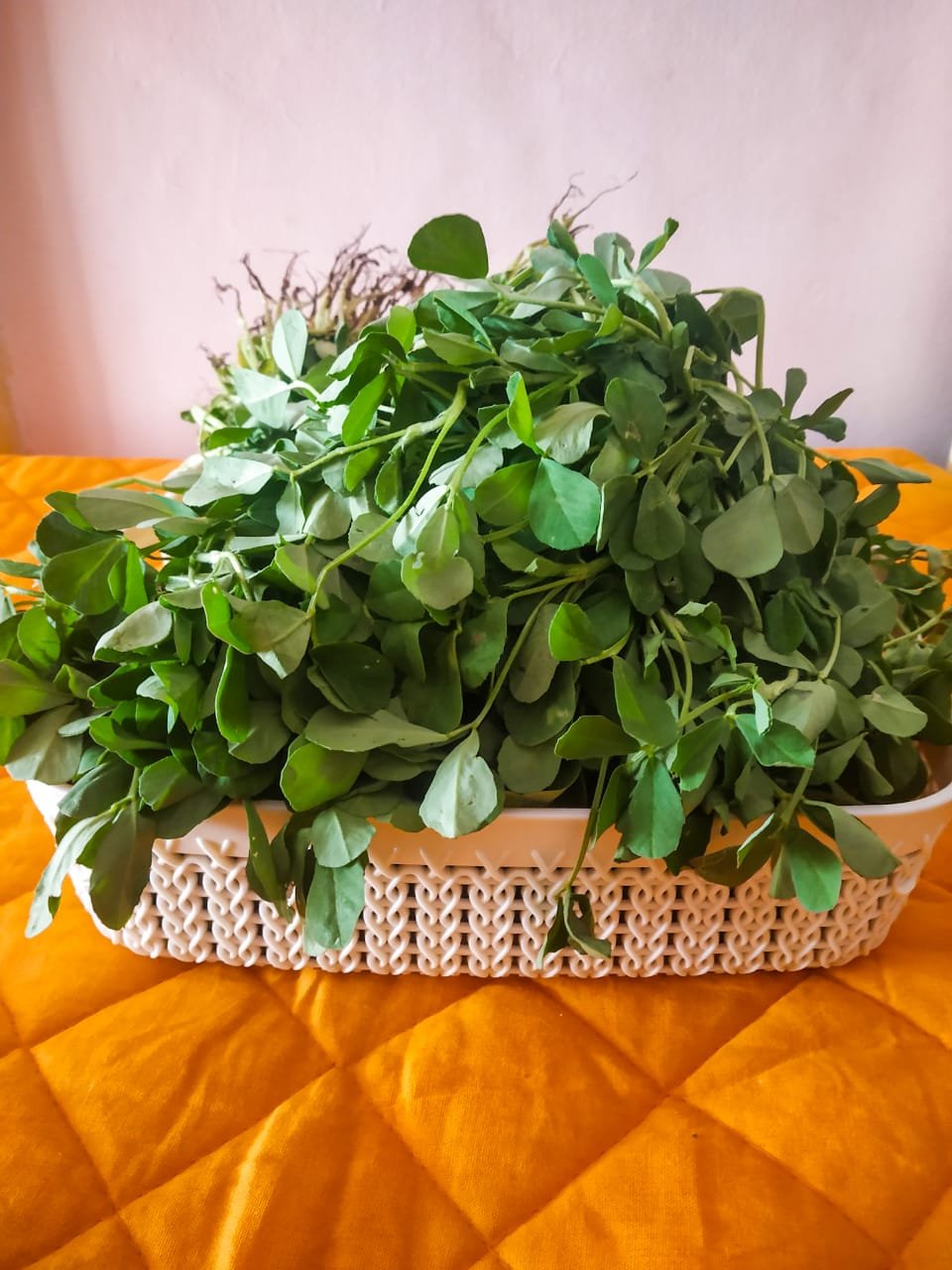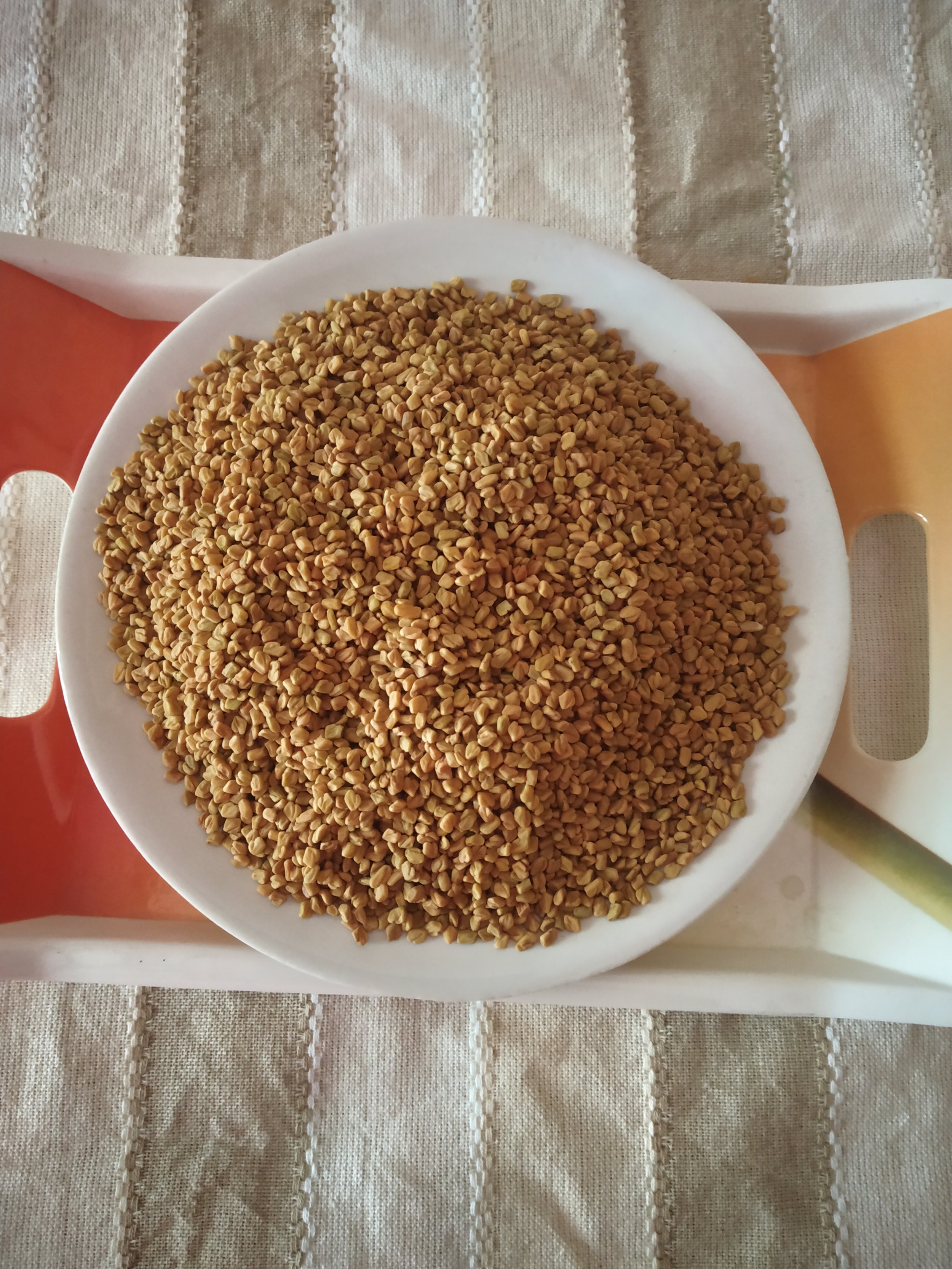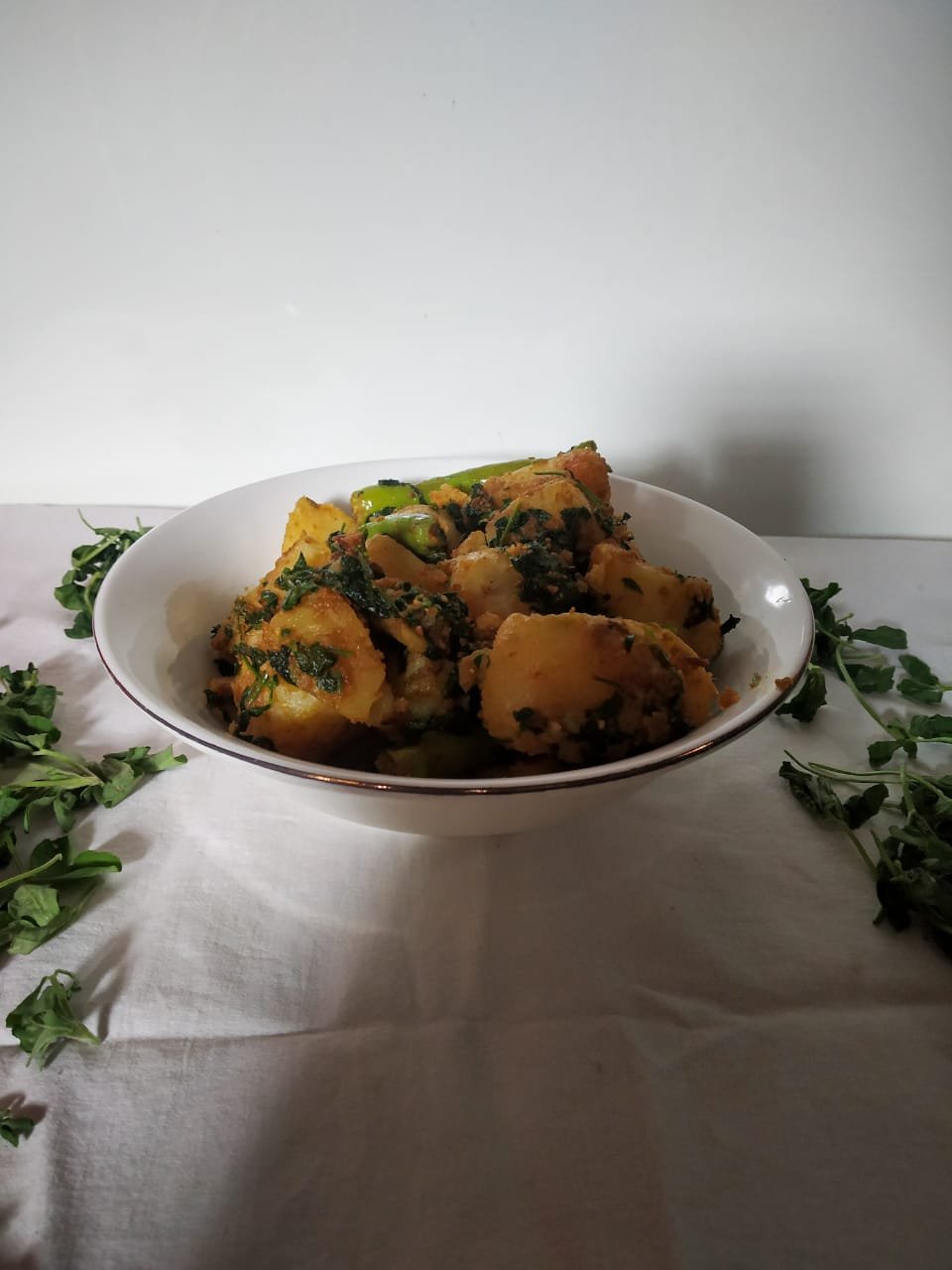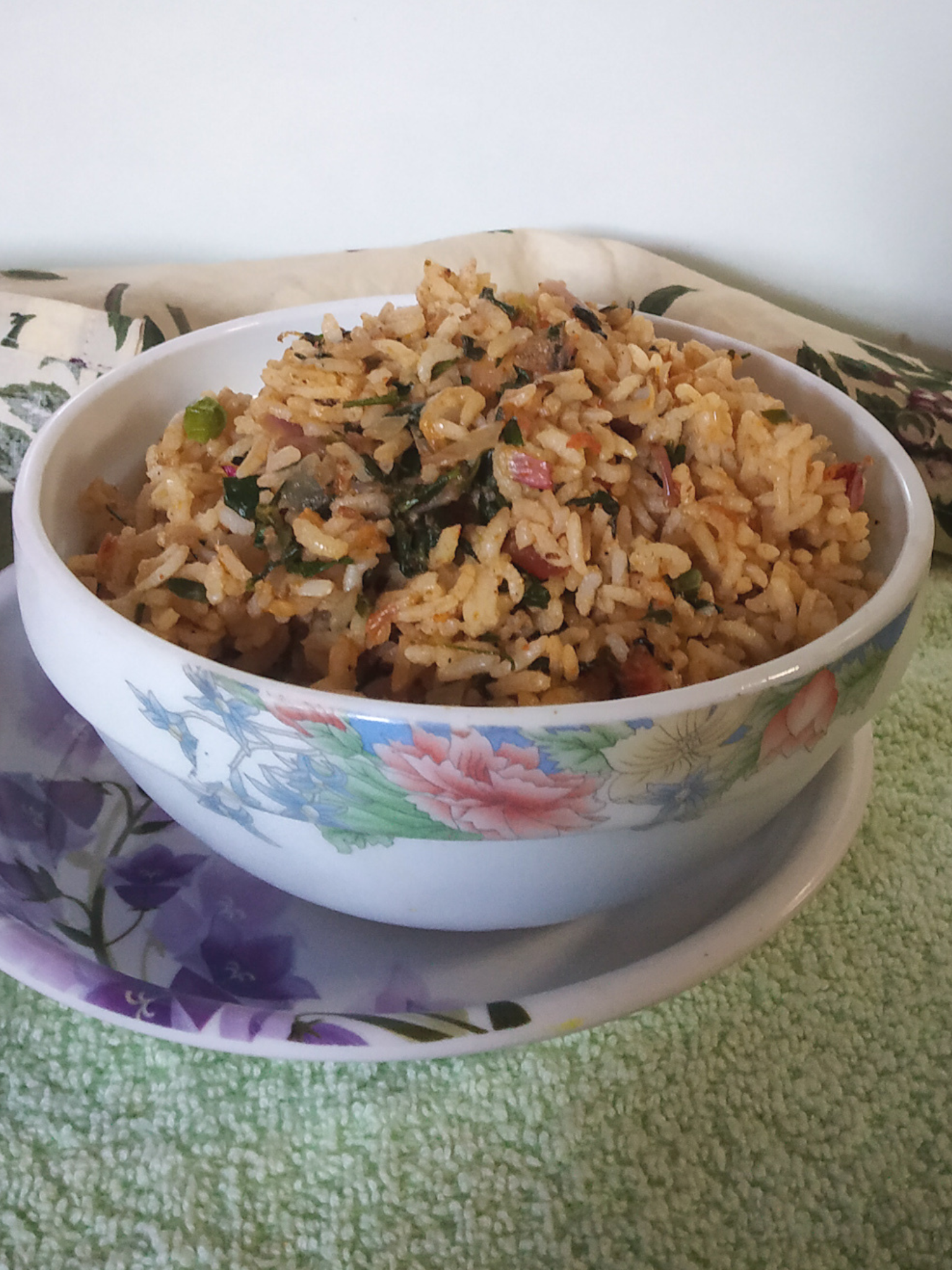Living with Natural Herbs: Fenugreek
Exploring magic of fresh Fenugreek leaves in Indian Food
Looking medicinally, Fenugreek (Trigonella foenum-graecum) is a native herb from Asia, Africa, Mediterranean, and Europe similar to clover. Seeds taste similar to maple syrup, and both leaves and seeds are used widely in foods and medicine across different cultures. Fenugreek seems to slow sugar absorption and stimulate insulin as a health-food remedy in people with diabetes. Fenugreek is also proposed to improve levels of testosterone and estrogen helping to improve interest in sex or sexual life. People commonly use fenugreek for many other conditions also, but there is no good scientific evidence to support most of those uses.
On the food side, Fenugreek leaves are widely used in multiple cuisines across the globe. They are packed with nutrients. They lend a good aroma and are versatile to use. In this article we will mainly focus on the food side of Fenugreek.
So What is fenugreek?
Fenugreek is a small cluster of leaves belonging to the Fabaceace family. It is a semi-arid, annual crop. The leaves are small and oblong growing closely. The seeds, tender shoots and leaves are known for their medicinal and culinary uses. The fenugreek leaves have a distinctive taste, they are slightly bitter but lend a good taste and aroma to the dish. They are small, oval shaped grown as multiple leaves on the twig. Fenugreek leaves are of two kinds. One is the larger variety with dark green, oval shaped leaves. It is slightly bitter in taste. The other is the small leaf with white thin stem. It is easier to use as the leaves can be easily trimmed.
Nutrition Value and Fenugreek as Methi.
Fenugreek leaves contain folic acid, thiamin, vitamin A, B6, and C, riboflavin, and niacin. It also contains minerals such as calcium, potassium, phosphorus and iron. 100 grams of fenugreek leaves provide us with 50 calories of energy. Fresh Fenugreek leaves can be stored for few days in the refrigerator. With stalk cut, Fenugreek can be kept enclosed in a paper cover, and can be used within two or three days. Fresh green fenugreek leaves are known as Methi and the their dried versions are known as Kasuri Methi in India. It is one of the essential ingredients in North Indian cuisine. It is used in miniscule quantities but lends a good taste to the dish. They are sold in small packets as a herbal spice in Indian grocery stores across the world.
A few benefits of fresh green fenugreek leaves :
● Low Calorie food: A cup of fenugreek leaves has only 13 calories. It satiates hunger and thus aids in weight loss. One can use it as a salad or in stir-fry.
● Good source of antioxidants : Fenugreek is a rich source of antioxidants. It contains Vitamin A, beta carotene and Vitamin C which helps to fight against common diseases, infections and inflammatory conditions. It helps to prevent cell damage by radicals. Thus, it helps in preventing infections and inflammations.
● Rich in fiber: Fenugreek leaves are a good source of fiber. 100 grams of fenugreek leaves contains 24.6 grams of dietary fiber. It aids in weight loss.It helps in satiation of hunger. Fiber rich food helps in proper bowel movements. It helps in preventing indigestion. It also reduces the risk of constipation.
● Controls Diabetes: Fenugreek leaves help to regulate the blood sugar level. The cholesterol level is also reduced with regular usage of these greens.Diabetes is a lifestyle disease caused by genetics, improper diet and lack of exercise. There Is an increase in the level of glucose. Studies show that 4HO-lle present in fenugreek helps in stimulating the insulin secretion.
● Bone health : Fenugreek is a good source of calcium, magnesium and Vitamin D. It helps in strengthening the bones and also stimulates bone healing. It can prevent osteoporosis and fractures.
● Good for skin health: Fenugreek contains Vitamin C. It helps in stimulating collagen. It prevents wrinkles and blemishes. It also has antioxidant properties that prevent inflammation.
● Helpful to breastfeeding mothers: Post pregnancy, new mothers are fed with a variety of fenugreek dishes as it promotes milk production.
Promotes hair growth : Fenugreek is a good source of nutrition. The paste of fenugreek seed is applied to the scalp for long, shiny hair. Fenugreek leaves is used in the treatment of gray hair.
Culinary uses:
Fresh fenugreek leaves are the winter greens which I love to use abundantly in my cooking as a fragrant spice or as a full dish as well. I like to use them in a variety of North Indian dishes such as dal, stir-fry vegetables and rice etc. For example, Aloo Methi (Potato-Fenugreek) subji is a delectable side dish made from fresh green leaves providing both nutrients as well as fiber to the meal. The dried leaves, called Kasuri Methi, on the other hand are an important fragrant spice in many or most of North Indian dal, chicken, meat, and dishes. It gives a good aroma to the dish and takes the cooking to a different level. The seeds are also an integral part of the spice mix in both North and South Indian cuisine. It is also used in pickles. Dried fenugreek leaves are also powdered and used as a herb for medicinal purposes.
In the Persian or Iranian cuisine, it is widely used in different kinds of dishes. For example, Eshkeneh is a soup and Ghormeh Sabzi is a popular side dish made using fresh fenugreek leaves. Fenugreek seeds are more popular in Armenian cuisine. It is made into a paste and beef is marinated with it and other ingredients to make Basturma. In Egyptian cuisine, a drink is made by boiling the seeds and it is consumed regularly. Fenugreek seeds are also some times used in making of spiced or flavored pita bread. In Indian Gujrati cuisine, or in the Western countries also, it’s leaves are used to make a savory flatbread called Thepla which goes well as a snack food by itself or eaten as a bread – spicy paratha, across most of the North India.
Do you know that fenugreek leaves can be eaten, both raw and cooked. The raw leaves should be washed thoroughly before consuming. It is good to mix with other vegetables, like in a Salad, to avoid or enjoy it’s bitter taste. A splash of fenugreek leaves in dry snacks, lends a good aroma and enhances the taste of the dish. Fenugreek is used as a herb, spice and vegetables. In Indian cuisine, methi dana is used in pickles. It is extensively used in varied spice mix.
In Armenian cuisine, fenugreek seed powder is made into a paste and covered over the basturma. In Egyptian cuisine, fenugreek is known by the name hilba. Seeds are boiled to make a drink which is regularly consumed. In Yemen, a small quantity of Oud Al Hilba , which is similar to Ashwagandha, is added to the fenugreek powder before mixing it with water. In Ethiopia, fenugreek is used as a natural herbal medicine to cure diabetes.
Two typical recipes with fresh Fenugreek leaves from Indian Cuisine
Aloo-Methi and Methi-Pulao (shown above)
1. Aloo Methi:
Aloo Methi is a popular side dish from the Indian subcontinent. It pairs well with any meal including Roti, Puri, Naan, Rice, Dal etc.
Ingredients:
2 teaspoon oil, ½ teaspoon cumin, ¼ teaspoon turmeric, 2 dry chili, 4 cloves garlic, 1 bunch of fresh fenugreek leaves , 4 medium size potatoes, ½ teaspoon red chili powder, ½ teaspoon coriander seed powder, Salt to taste
Recipe:
Cut and wash the fenugreek leaves. Wash and boil the potato with skin for two whistles in the pressure cooker. Once the pressure releases, peel the skin and cut into cubes. Take oil in a pan, add cumin. As it splutters, put garlic, chilli and turmeric powder. Saute for a minute. Throw in the fenugreek leaves, let cook for a minute. Now, put the spice powders. Add turmeric powder, coriander powder,chilli powder and salt. Mix it and allow to cook for a minute. Now, add the potato cubes to it and mix. Let cook for two minutes on a medium flame. Aloo Methi is ready to serve.
2. Methi Pulao
Methi Pulao is some variation of spicy and frangrant rice dish like Biryani or Pulao with main flavor and frangrance coming from fresh Methi or fenugreek.
Ingredients:
1 cup rice, 2 cup water, 2 tablespoon oil, ½ teaspoon cumin, 1 onion, 2 tomato , 2 cup fresh fenugreek leaves, ¼ teaspoon turmeric powder, ½ teaspoon chilli powder, ½ teaspoon garam masala powder. Salt to taste.
Recipe:
Prepare rice in a pressure cooker. The grains of the rice should be separate. The usual quantity of water required to prepare rice is 1: 2, but it again depends on the quality of rice. Once the pressure releases, put the rice in a wide plate or bowl. In the meantime, cut onion and tomato into small pieces. Wash the fenugreek leaves and chop them. Take oil in a pan, add cumin. Once it splutters, add onion pieces. Let cook for sometime, it should be translucent. Now, add tomato to it. Once the tomatoes are tender, put in the fenugreek leaves and cook for a minute. Put turmeric powder, chili powder, garam masala and salt in it. Give a mix and put it aside.
Bottom line:
Fenugreek leaves are packed with nutrients. It is versatile to use. But do not consume it in excess, it may cause other related problems or side effects such as upset stomach or diarrhea. Also avoid using if you are allergic to it.
By Jayashree Trao, India






